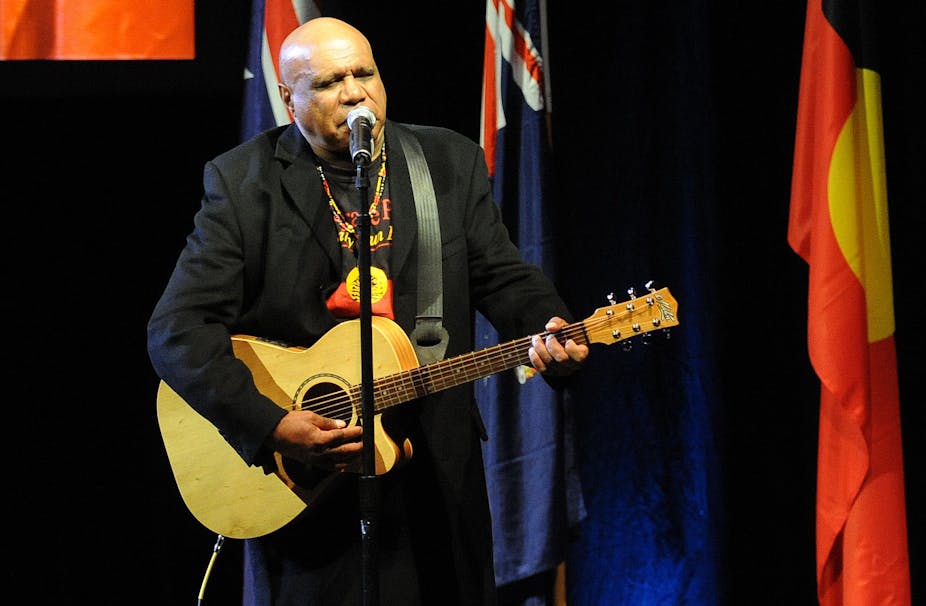Beliefs and ceremonies associated with death in Indigenous Australia are diverse. Death and the deceased are sacred to Indigenous Australians and ceremonies differ between communities.
They may involve lengthy ceremonies lasting several days with strict protocols around language, names, images and other possessions. Alternatively deaths might be marked by funerals that can include images and speaking the deceased person’s name, performances and other tributes.
While some may argue this type of funeral service is a western practice adopted by Indigenous people, anyone who has attended an Indigenous funeral can attest to the way Indigenous people adapt the ceremony to suit local cultural protocols and norms.
This was evident at the late Aboriginal activist Charles “Chicka” Dixon’s state funeral at the Sydney Town Hall in 2010. The ceremony featured Aboriginal body paint, the Black Power salute, and the coffin was draped in the Aboriginal flag.
Like ceremonies for death, there are many and varied ways Indigenous people memorialise the deceased. Rituals and memorials honouring the life and death of family and community members are important in the facilitation of healing.
Memorialisation is an ever-present human practice and my research into Aboriginal identity and community online reveals that there are some emerging trends in Indigenous Australia.
One such trend is memorial tattoos; the other is the rise of memorial pages on Facebook.
Memorial tattoos

Tattoos and mourning rituals have been around for centuries in many cultures but they are a fairly recent phenomenon in Indigenous Australia. Memorial tattoos provide an abiding presence of the deceased person.
Memorial tattoos also communicate personal and community identity – like the death of the loved one, the tattoo is permanent. The tattoo is a constant reminder keeping the memory and story alive for ones self and for others.
One participant in my research, a man named Christopher O’Brien (who is happy to be identified), has shared his ink story (see main image) which is a tribute to his late Uncle Kevin. As Christopher explained:
The Aboriginal Flag represents my culture, heritage, country and passion as an Aboriginal man. The dates are the birth and death dates of my Uncle. The foot prints going down my spine (the core of my journey in life) from the Western Suburbs of Sydney tracking down to my Country/community.
The footsteps then lead to the “Long-neck Turtle” (my totem) of the Murray River (as my mob are freshwater people). The turtle is designed with lines, which represents my “clan” Yorta Yorta. The eucalyptus gum tree leaves are significant trees in/on my country (Cummeroogunja), as is the Murray Rivers waters.
Within the waters is scribed my clan “Yorta Yorta” and below that “Cummeroogunja” – which means “Our Home”. Then at the bottom of my spine is the big red Kangaroo, which is a significant animal representing our ancestors, who have come back to look after us (our people) and our country (land).
Memorials on Facebook
The other trend is memorials on Facebook.
Indigenous Australians – like most other people – are avid social-media users and Facebook is by far the most popular site. There is no doubt social media is transforming the way we interact with each other and how we connect to other people at a local, regional, national and global level.
Facebook and other social-network sites facilitate this interaction and allow users to maintain relationships across vast distances and time zones, thereby increasing social connectivity. This is extremely important as Indigenous people can be separated from kin and community as they seek financial and educational opportunities.
Social network sites have transformed the way we keep in touch and distribute news – including the news of death. Social media is very effective for sharing information with interested or relevant others and this is particularly the case when there is a death.
One of my participants spoke about using Facebook to keep in touch:
Yeah. People put up a status of sympathy to the family. If they can’t make the funeral, they will say sorry on Facebook.
When it comes to cultural protocols around images there are varying opinions. For some, photos are ways of honouring the deceased; for others they are forbidden. One participant said:
Some people have got different feelings, some families like people putting photos on Facebook, but some people don’t like it.
Indigenous Australians often refer to memorial pages as “Sorry Pages”:
Sometimes, if that person’s family passed, send condolences to that family. Write things, “thinking of you”. But they don’t have sorry page. They send it to me, and I message it to other family. Like “miss him, he was a good person”. Some people like, but some people don’t like it.
R.I.P trolls
R.I.P trolling is a concern – when instigators post abusive comments and memes on to Sorry Pages dedicated to the deceased.
This type of online vandalism is not a new phenomenon for Indigenous people who are often targeted by racism and abuse on social media. Sadly, even when Facebook removes offensive pages and blocks content for Australian users the content remains available for users outside of Australia and is shared and reposted repeatedly.
In spite of the presence of the trolls, Indigenous people continue to use social media tools to adapt new ways of memorialising the dead and sharing condolences via Sorry Pages.
Tattoos and Facebook pages may not conform to everyone’s expectations of Indigenous cultural practice but these emerging trends help facilitate healing as well as demonstrating the diversity of Indigenous commemorations across the nation.
The Conversation is currently running a series on Death and Dying.

